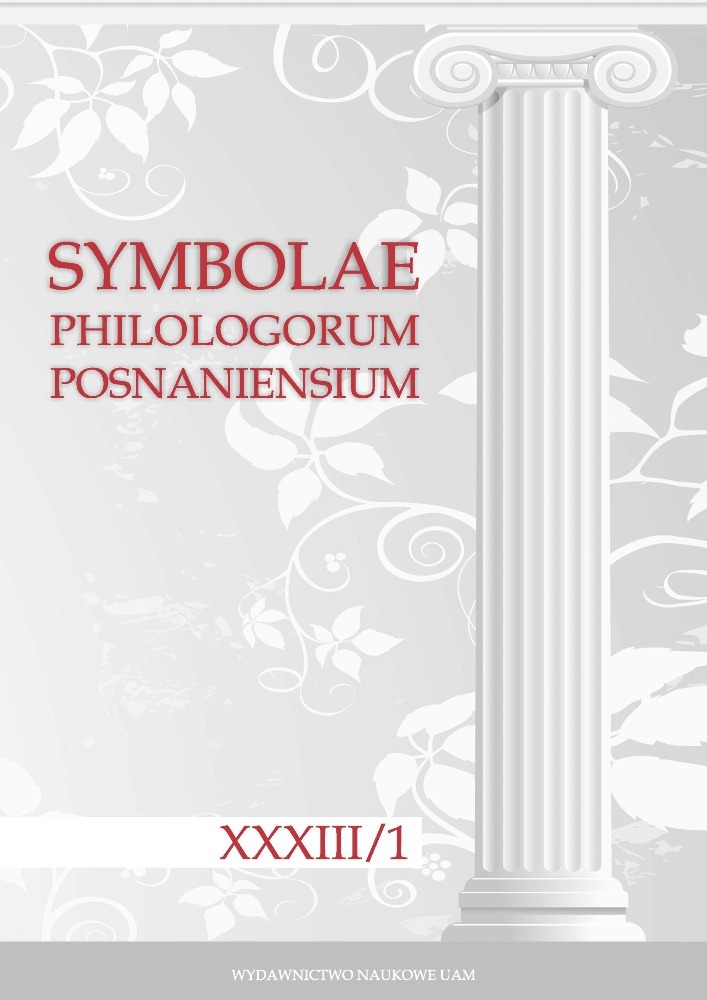Abstrakt
The article presents a new proposal to supplement v. 12 of the anonymous hexametric piece containing, most likely, the lament of Ariadne abandoned by Theseus on Naxos. The suggestion offered here (οὐκ or, better, οὐδ’ αἰδ]ὼς ἐν ὀνείρωι instead of δήλ]ωσεν ὀνείρωι or ὡς ἐν ὀνείρωι developed by other scholars) allows us to guess that the piece may have expressed Ariadne’s contradictory feelings and her moral dilemma.
Bibliografia
Bartoletti Manfredi 1979: V. Bartoletti, M. Manfredi, Papiri della Società Italiana XV, Firenze 1979.
Perale 2020: M. Perale, Adespota Papyracea Hexametra Graeca (APHex) I, Berlin 2020. DOI: https://doi.org/10.1515/9783110295085
Bartoletti Bastianini Messeri Montanari Pintaudi 2008: V. Bartoletti, G. Bastianini, G. Messeri, F. Montanari, R. Pintaudi, Papiri greci e latini, vol. XV, Firenze 2008.
Brunel 1996: Companion to Literary Myths, Heroes and Archetypes, ed. P. Brunel, translated by W. Allatson, J. Hayward and T. Selous, London 1996.
Cairns 1993: D. L. Cairns, AIDOS. The Psychology and Ethics of Honour and Shame in Ancient Greek Literature, Oxford 1993.
Calzascia 2015: S. C. Calzascia, Il carme 64 di Catullo e le Argonautiche di Apollonio Rodio, Bologna 2015.
Elsner 2007: J. Elsner, Viewing Ariadne: From Ekphrasis to Wall Painting in the Roman World, CPh CII (2007) 20–33. DOI: https://doi.org/10.1086/521130
Elsner 2007a: J. Elsner, Roman Eyes. Visuality and Subjectivity in Art and Text, Princeton 2007, 67–109. DOI: https://doi.org/10.1515/9780691240244
Erffa von 1937: C. E. von Erffa, ΑΙΔΩΣ und verwandte Begriffe in ihrer Entwicklung von Homer bis Demokrit, Leipzig 1937.
Fayant 2003: M.-Ch. Fayant, Nonnos de Panopolis. Les Dionysiaques, tome XVII, texte établi et traduit par M.-Ch. Fayant, Paris 2003.
McNamee 2008: K. McNamee, Annotations in Greek and Latin Texts from Egypt, Chippenham 2008. DOI: https://doi.org/10.3998/mpub.9749749
Meliadò 2013: C. Meliadò, Note testuali a papiri epici, ZPE CLXXXVI (2013), 51–56.
Miguélez-Cavero 2008: L. Miguélez-Cavero, Poems in Context: Greek Poetry in the Egyptian Thebaid 200–600 AD, Berlin 2008. DOI: https://doi.org/10.1515/9783110210415
Miguélez-Cavero 2016: L. Miguélez-Cavero, Nonnus and the Novel, in: Brill’s Companion to Nonnus of Panopolis, ed. D. Accorinti, Leiden-Boston 2016, 549–573. DOI: https://doi.org/10.1163/9789004310698_027
Pernigotti 2003: C. Pernigotti, Notizie relative allo stato attuale del XV volume dei Papiri della Società Italiana, “Comunicazioni dell’Istituto Papirologico G. Vitelli” V (2003), 61–72.
Rose 1940: H. J. Rose, Nonnos. Dionysiaca, Books 36–48 with an English translation by W.H.D. Rouse, mythological introduction and notes by H.J. Rose, notes on text criticism by L.B. Lind, Cambridge (Mass.) - London 1940 (repr. 1998).
Schoess 2022: A. S. Schoess, Objects of the Lusting Gaze: Viewing Women as Works of Art in Late Antique Poetry, in: Greek and Latin Poetry of Late Antiquity. Form, Tradition, and Context, eds. B. Verhelst, T. Scheijnen, Cambridge 2022, 221–240. DOI: https://doi.org/10.1017/9781009031769.015
Shorrock 2014: R. Shorrock, A Classical Myth in a Christian World. Nonnus’ Ariadne Episode (Dion. 47.265–745), in: K. Spanoudakis ed., Nonnus of Panopolis in Context. Poetry and Cultural Milieu in Late Antiquity, Berlin-New York 2014, 322–324. DOI: https://doi.org/10.1515/9783110339420.313
Verhelst 2017: B. Verhelst, Direct Speech in Nonnus’ Dionysiaca. Narrative and Rhetorical Functions of the Characters’ “Varied” and “Many-Faceted” Words, Leiden-Boston 2017.
Webster 1966: T.B.L. Webster, The Myth of Ariadne From Homer to Catullus, “Greece and Rome” XIII (1966) No 1, 22–31. DOI: https://doi.org/10.1017/S0017383500016107


